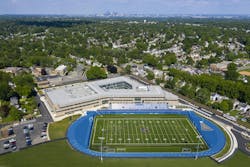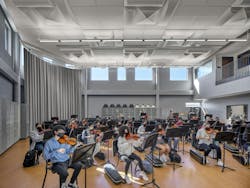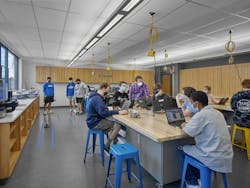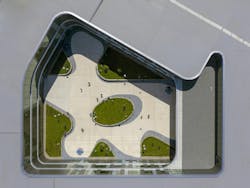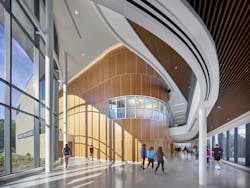A graceful design opens Pennsylvania’s Springfield High School to its community
Springfield High School, in the suburbs of Philadelphia, dated back to 1953, was well passed its expiration date. To replace that aging building, Springfield’s school board called upon architect Perkins & Will to design a new, 230,000-sf facility that is separated into three zones—academic, physical education, and visual and performing arts—within somewhat smaller footprint.
Construction of this three-story project—which sits on a former baseball field and had been in the works since 2009—began in 2018, at an estimated cost of $130 million, and opened for 1,500 students in 2021. The project’s Building Team included E.R. Stuebner (GC), Boro Construction (ME and EE), and Stan-Roch Plumbing (PE).
The exterior design of the new school is distinguished by an outer shell of curving beige brick and glass. Daylight fills the school’s wood-paneled hallways and ceilings, as well as its open learning commons that are placed strategically throughout the academic zone to allow for informal student interactions.
The school highlights a popular recent design trend by allowing its library to “spill” into its cafeteria, thereby creating another informal learning area. (The cafeteria and auditorium can be used for public events, too.
Common spaces open directly onto the large courtyard, whose inner periphery is made up of glass and metal panels that separate it from the outer space. This flexibility accommodates a range of activities, and connects the facility to the surrounding community.
MULTIFUNCTIONAL SPACES
Because of its smaller footprint, the school’s most heavily used spaces—such as its lobby, cafeteria, and courtyard—are set up for greater efficiency. For example, the cafeteria can serve as “pre-function” space for the gym and for community space during evening hours. The school’s gyms open to each other, and therefore can handle overflow seating during events.
The smaller building is also more energy efficient, and allows for easier sharing of amenities. And by focusing density closer to the town’s urban core, the school’s playfields are positioned as virtual extensions of nearby Whiskey Run Creek and Spring Valley Park.
The new school is within walking distance of the town, and adjacent to public transportation. Indeed, the school is organized to provide access to the public: the auditorium, for example, is located off the main entrance so it can be used by the community for non-school events. Practice fields are open to the public. And in phase two of this redevelopment, the site of the old school will become a green space in the heart of the town’s residential area.


